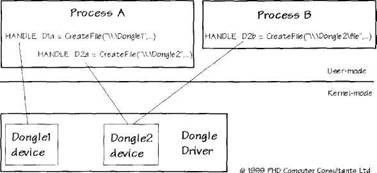Книга: Writing Windows WDM Device Drivers
Devices
Разделы на этой странице:
Devices
A driver implements one or more devices. Each device represents an instance of a piece of real or virtual hardware. User-mode programs and the kernel access a driver's device through a device object.
Once a WDM driver's DriverEntry routine has completed, the driver has usually not created any devices. Instead, it has provided the kernel with various callback routine pointers. The Plug and Play (PnP) Manager calls the driver AddDevice callback routine each time the driver should create a device. The PnP Manager makes further calls to configure the device using the PnP IRP, as described in Chapter 8.
This chapter considers only two Plug and Play messages: when a device is added using AddDevice, and when it is removed. The Remove Device message is a PnP IRP with a minor function code of IRP_MN_REMOVE_DEVICE.
Device Access
User mode programs access drivers using the Win32 CreateFile function, passing a string in the lpFileName parameter. This routine is normally used to access files on disk. However, it can also be used to access a variety of other devices, such as pipes, mailslots, communication resources, or the console. At the simplest level, specifying C0M1 opens the first serial port.
To access other devices, use . at the start of the lpFileName string. The following characters specify the device to open. For example, COM1 can also be opened as .COM1. This form allows devices beyond COM9 to be opened. For example, opening C0M10 will not work but .COM10 will work (assuming such a device exists).
To access a device created by a driver, you must know the symbolic link name of the device. A symbolic link name is simply the name of the device exposed by the driver. Creating these names is described later.
Suppose a driver called Dongle has created a device with a symbolic link of Dongle1. A Win32 program could open it using .Dongle1 as the filename parameter passed to CreateFile.
There are two aspects to opening files that are important to understand. The first is that a device can be opened more than once, either in the same process or by different processes or threads. A driver can state that a Win32 thread gets exclusive access to the device until the handle is closed. Or the Win32 program can request exclusive access by setting the CreateFile dwShareMode parameter to zero. Alternative settings of dwShareMode permit other open requests if they specify read and/or write access. Even if a Win32 thread has exclusive access to a device, it can use overlapped I/O to issue more than one request to a driver at the same time.
Your device should cope with access through multiple handles, if it permits nonexclusive access. For example, if your device supports the notion of a file pointer, it has to survive "simultaneous" read or write requests at the same file pointer location. The usual technique is to serialize all requests so that they are processed in full, one by one, as described in Chapter 16.
The second important aspect of opening a device is that Win32 programs can use file or directory names after the device name. A driver must decide whether it supports the concept of "files" when a process opens a device handle. For example, .Dongle1dir1file1 could be used in the call to CreateFile. It is up to you whether your driver interprets such information.
Figure 5.1 illustrates a possible device access situation. The Dongle driver has created two devices, called "Dongle1" and "Dongle2". Process A has opened handles to each of the Dongle devices. Process B has opened a handle to "file" on the "Dongle2" device.
Figure 5.1 Device access

Subsequent I/O
Once a user mode program has opened a handle to your device, it can use various Win32 routines to access it, such as ReadFile, WriteFile, DeviceIoControl, and CloseHandle. Each of these calls results in a request being passed to your driver in the form of an I/O Request Packet (IRP). If a Win32 program terminates abruptly and finishes without calling CloseHandle, Windows ensures that this call is made (after cleaning up any pending I/O requests).
The Wdm1 handlers for these IRPs are described later, along with an introduction to the AddDevice and IRP_MJ_PNP handlers.
- Introduction to Serial Devices
- 18.2.5. Block devices
- Selecting backup devices and media
- A Tour of Linux Network Devices
- Accessing Serial Devices
- Serial Devices and the login: Prompt
- Network Devices Supporting IPX
- Identifying Available Devices Through the port File
- Using removable storage devices
- Using print devices
- Installing and configuring physically attached print devices
- Installing network-attached print devices




